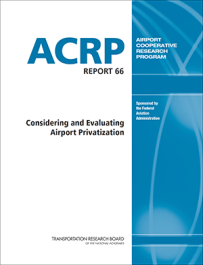The Transportation Research Board of The National Academies published ACRP Report 66: Guidebook for Considering and Evaluating Airport Privatization, for which LeighFisher was the primary research consultant. The guidebook was designed to assist U.S. airport owners, policymakers, and other relevant stakeholders consider and evaluate the potential advantages and disadvantages of implementing various approaches to airport privatization. The guidebook is intended to be a comprehensive resource that summarizes in a concise and easy-to-understand format the various options for private sector involvement in the operation, management, and financing of airports in the United States and provides the tools necessary to evaluate such options to make sound decisions about potential privatization initiatives.
Local and regional governments continue to look for ways to make their airports as efficient, competitive, and financially viable as possible, as well as ways to maximize the community’s return from its airport assets. Communities have promoted and continue to promote private sector participation in airports in pursuit of those goals. Whether or not to enlist or expand private sector participation in an airport can be a significant decision with long-term consequences for communities, governing boards, airport officials, airlines, investors, and other stakeholders.
Privatization does not have to be an all-or-nothing solution; the airport owner can choose to privatize portions of an airport’s management or operation. The guidebook identifies and outlines realistic options and highlights a variety of successful and unsuccessful privatization initiatives through case study examples.
Examples of Privatization Strategies
The guidebook begins with a discussion of generic privatizations models and the context for applying them in the United States. It then describes in more detail the specific strategies, legal and regulatory conditions, and objectives, advantages, disadvantages, and risks associated with each strategy in order from the least to most private sector involvement. Numerous examples of the various ways U.S. airport owners have engaged private sector companies to operate, manage, finance, and develop their airports are provided to illustrate the depth and extensive long-term U.S. experience with private operation of airport functions and activities. The guidebook also includes a decision-tree matrix, evaluation checklist, and process to help airport owners understand the process and considerations involved in identifying and evaluating realistic options for private sector involvement. Detailed case studies summarize the lessons learned for a range of airport sizes, privatization strategies, and forms of governance for both successful and unsuccessful privatization efforts, as well as airports within and outside the United States.
Privatization Case Studies
Appendices C through H provide additional rich information:
Appendix C - International Airport Privatization, Lessons Learned, and Transaction Summaries
Appendix D - Non-Airport Privatization in the U.S. Transport Sector
Appendix E - Emerging Domestic Issues Influencing U.S. Airport Privatization
Appendix F - U.S. Regulatory and Policy Framework
Appendix G - Key Stakeholder Interests and Concerns
Appendix H - Detailed Case Studies















































